Share of adults ‘basically content’ with federal government rises to highest point since 2004, driven by Democrats
Pew Research Center conducted this study to understand Americans’ evaluations and expectations of the federal government. For this analysis, we surveyed 5,109 U.S. adults conducted April 5-11, 2021. Everyone who took part in this survey is a member of Pew Research Center’s American Trends Panel (ATP), an online survey panel that is recruited through national, random sampling of residential addresses. This way nearly all U.S. adults have a chance of selection. The survey is weighted to be representative of the U.S. adult population by gender, race, ethnicity, partisan affiliation, education and other categories. Read more about the ATP’s methodology.
Here are the questions used for the report, along with responses, and its methodology.
As public trust in the federal government remains low, Americans continue to say the federal government has a responsibility to provide support and services for all Americans in a number of forms.
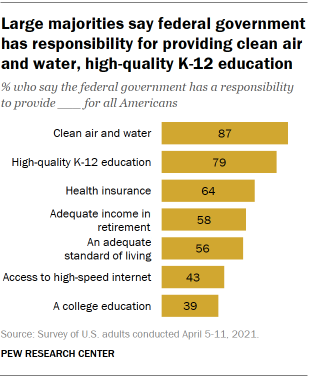
U.S. adults broadly agree that it is the federal government’s role to provide clean air and water (87%) and high-quality K-12 education (79%) for all Americans. More modest majorities say it is the government’s responsibility to provide health insurance (64%), adequate income in retirement (58%) and an adequate standard of living (56%).
Fewer than half – about four-in-ten – say it is a responsibility of the government to provide access to high-speed internet (43%) or a college education (39%).
A new Pew Research Center survey, conducted April 5-11 among a nationally representative sample of 5,109 adults who are members of the Center’s American Trends Panel, finds that public views about the federal government’s responsibilities are little changed since before the start of the coronavirus outbreak. One exception is that the share of Americans who say the government has a responsibility to provide access to high-speed internet has increased by 15 percentage points since September 2019 (from 28% to 43%).
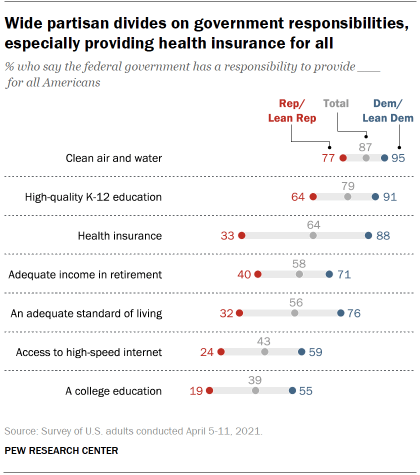
While majorities of Democrats and Democratic-leaning independents say the government should have a role in all seven of the domains included on the survey, majorities of Republicans and Republican leaners see only two as the federal government’s responsibility: providing clean air and water (77%) and high-quality K-12 education (64%).
Partisans are furthest apart on whether it is the government’s responsibility to provide health insurance for all Americans: Nearly nine-in-ten Democrats (88%) say this is a responsibility of the government, compared with a third of Republicans.
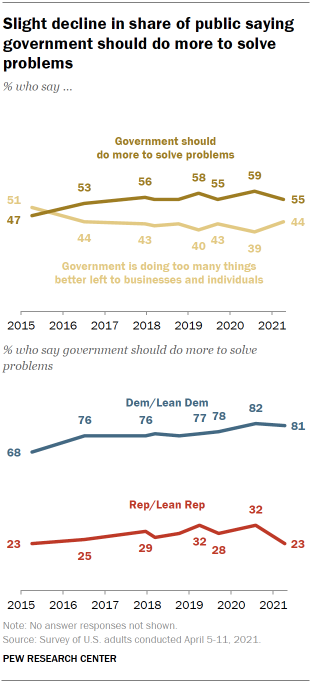
The survey also finds that the share of the public that says the government should do more to solve problems has declined slightly since last year.
In August 2020, about six-in-ten (59%) Americans said the government should do more to solve problems. Today, 55% hold this view, while 44% say the government is doing too many things better left to businesses and individuals.
The share of Republicans who say the government should do more has dropped from 32% last year to 23% today. About three-quarters of Republicans (77%) say the government is doing too many things better left to business and individuals.
By comparison, the share of Democrats who say the government should do more to solve problems is essentially unchanged over the last year: 81% Democrats say the government should do more to solve problems today, compared with 82% in August.
Other findings from the survey
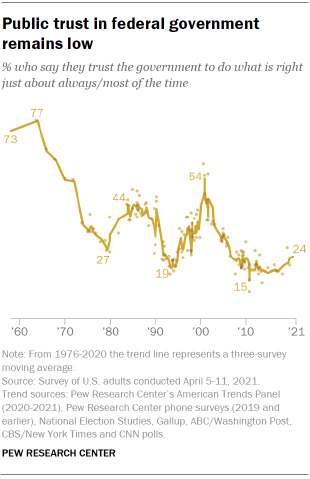
Public trust in the government remains low. Today, about a quarter of Americans (24%) say they trust the federal government to do what is right just about always or most of the time. The share of Democrats who say they trust the government just about always or most of the time has increased substantially since before the presidential election: More than a third (36%) now say this, compared with 12% in August 2020. Conversely, GOP trust in government has sharply declined over the same period: Last year, 28% of Republicans and Republican leaners said they trusted the federal government to do what is right all or most of the time; just 9% say this today.
More Americans are “basically content” than “angry” with the federal government. The share of Americans who say they are basically content with the federal government is now higher than at any point since 2004, while the share saying they feel angry with the government is lower than it has been in recent years. Still, far more say they feel frustrated with the government (52%) than either angry (17%) or content (29%).
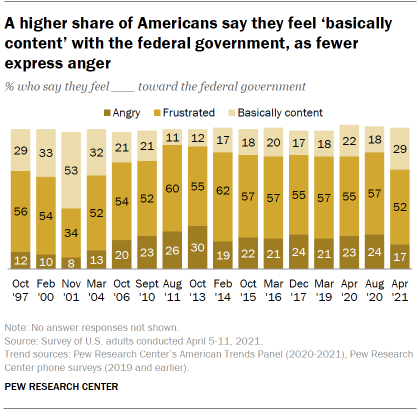
This change in feelings about government is mostly driven by a shift among Democrats. Fully 43% of Democrats say they are content with the federal government – the highest share of Democrats expressing contentment with the government in nearly 20 years. By comparison, just 13% of Republicans say they feel content toward the federal government.
Little change in views of government responsibilities
For the most part, opinions about what Americans say the federal government is responsible for have remained relatively stable since 2019.
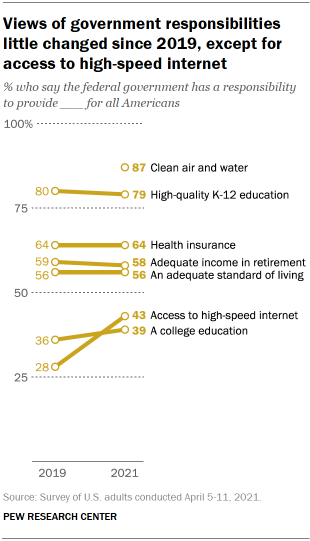
There has been no significant change in the share of Americans saying the federal government has a responsibility to provide four of six items asked about in both 2019 and 2021: high-quality K-12 education, health insurance, adequate income in retirement and an adequate standard of living.
Americans are now slightly more likely to say the federal government has a responsibility to provide a college education to all Americans than they were in 2019 (39% today vs. 36% then).
The only item to see a significant change since 2019 asks whether the federal government has a responsibility to provide access to high-speed internet for all Americans. Today, about four-in-ten Americans (43%) say the federal government does have this responsibility; 28% said this two years ago.
Wide age, race and income differences in views of government responsibilities
As was the case two years ago, there are wide demographic differences in what is seen as in the domain of the federal government’s responsibilities.
There is broad agreement across demographic groups that the federal government should be responsible for providing clean air and water, as well as high-quality K-12 education. On five of the other seven measures asked on this survey, White adults, those ages 65 and older and people with higher incomes are far less likely than those in other groups to say the government has a responsibility to provide these services to all Americans.
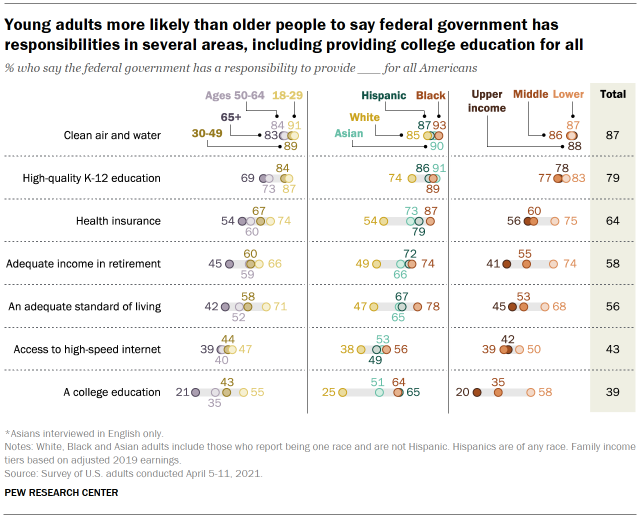
For example, solid majorities of Black (87%), Hispanic (79%) and Asian (73%) adults say the federal government has a responsibility to provide health insurance to all Americans, compared with about half of White adults (54%).
And with few exceptions, lower-income adults take a more expansive view of government’s responsibilities than do middle- and higher-income people. For instance, about seven-in-ten lower-income adults say the government should be responsible for providing all Americans with an adequate standard of living (68%), while smaller similar shares of middle-income (53%) and upper-income (45%) people hold this view.
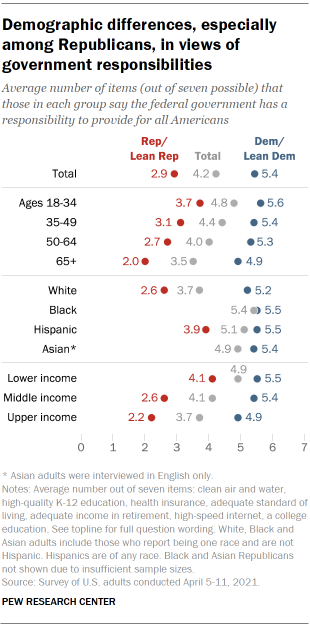
There also are age differences in views of some government responsibilities. Notably, while more than half of adults under 30 (55%) say the government has a responsibility to provide Americans with a college education, that falls to 43% among those ages 30 to 49 and to 35% among those 50 to 64. Only about two-in-ten adults 65 and older (21%) say this is the responsibility of the federal government.
On average, lower-income, Black, Hispanic, Asian and younger adults designate more of the seven items included in this survey as responsibilities of the federal government than do higher-income, White and older adults. While adults ages 18 to 34, on average, say 4.8 out of the seven should be responsibilities of the federal government, this average decreases steadily with age – with those 65 and older naming an average of 3.5 items. And lower-income adults indicate an average of 4.9 of the listed items should be provided by the federal government for all Americans, compared with an average of 3.7 among upper-income adults. White adults select an average of 3.7 items, compared with an average of around 5 items among Black (5.4), Hispanic (5.1) and Asian adults (4.9).
While these patterns by income, race and ethnicity, and age are seen within both partisan coalitions, the gaps are substantially wider among Republicans than they are among Democrats.
Lower-income Republicans indicate it is the government’s responsibility to provide an average of 4.1 of the seven items. By contrast, middle-income Republicans select an average of 2.6, while upper-income Republicans see an average of just 2.2 of the seven as the government’s responsibility.
Hispanic Republicans see an average of 3.9 of these items as responsibilities of the federal government, while White Republicans identify an average of 2.6 as responsibilities of the government.
Additionally, while Republican adults under the age of 35 say an average of 3.7 of these items are responsibilities of the federal government, Republicans 65 and older view only about half as many items (2.0 of the seven) as the federal government’s responsibility.
This pattern is seen across each of the individual items. For instance, while about three-quarters of Republicans under age 35 (76%) say a high-quality K-12 education is the responsibility of the federal government, only about half of those 65 and older (51%) say this.
Among Democrats there also are income, racial and ethnic, and age differences in these views, though they are considerably less pronounced. Overall, Democrats say an average of 5.4 of these seven items should be a responsibility of the government to provide for all Americans. And Democrats under 35 view an average of 5.6 of these as government’s responsibility, compared with an average of 4.9 among Democrats 65 and older.
On several of these items there are only slight – or no – differences in the shares of Democrats across income, race and age groups who view each as a responsibility; however, there are wider divides on the question of whether the federal government has a responsibility to provide a college education to all Americans. About seven-in-ten lower-income Democrats (68%) say the government has this responsibility, compared with 32% of upper-income Democrats. There is also a substantial age gap among Democrats on this issue, with younger Democrats more likely to say the government has a responsibility to provide a college education to all.
Public trust in government remains low
While trust in the federal government among both Republicans and Democrats remains low compared with previous decades, there has been some movement among partisans over the last year. As in the past, partisans who are associated with the party holding the presidency are more likely to say they trust the federal government than those who are affiliated with the opposing party.
Today, just 9% of Republicans and Republican-leaning independents say they trust the federal government to do what is right at least most of the time. This is roughly on par with GOP trust in government throughout the Obama administration, though considerably lower than the roughly three-in-ten Republicans who expressed trust in government last year, during the Trump administration’s last year in office.
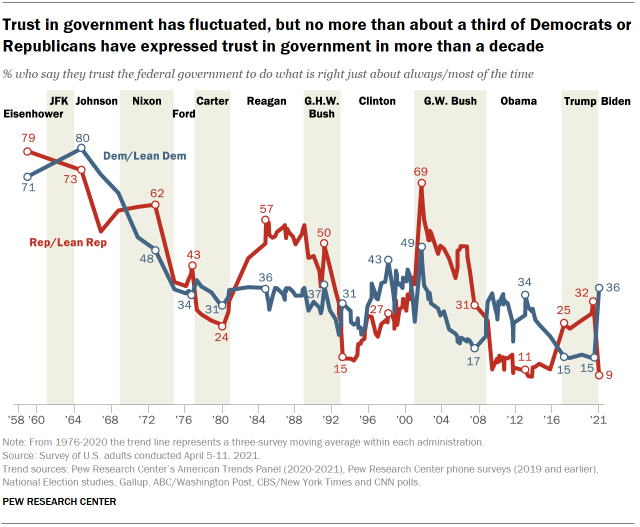
In contrast, Democrats and Democratic leaners now express more trust in government than they did last year. Today, 36% say they trust the federal government to do what is right, comparable to the share of Democrats saying this early in the Obama administration, and Democratic trust in government is now considerably higher than it was during the Trump presidency.
Similarly, while there has been a relatively modest overall change in Americans’ feelings toward the federal government since 2020, Democrats are now far more likely to express contentment with government than to say they feel angry – a stark shift from last year. The reverse is true among Republicans. As in the past, frustration with government is more widespread than either anger or contentment. Today, just over half of both Republicans (55%) and Democrats (52%) say they feel frustrated toward the federal government.
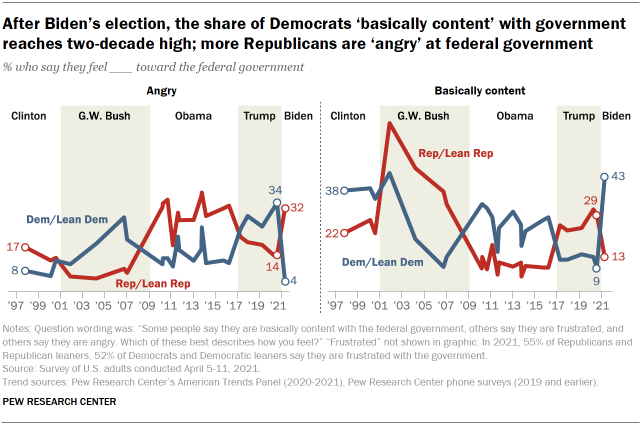
The share of Democrats who say they are basically content with government has increased dramatically since the fall of 2020 – from 9% to 43% – and now stands at its highest level in roughly two decades.
Among Republicans, by contrast, the share saying they are content with the government has declined, while the share saying they are angry has increased. Today, about a third of Republicans (32%) say they feel angry with the government, compared with just 14% who said the same in August of last year. The share of Republicans who say they are angry with the federal government is comparable to the share who said the same during the end of the Obama administration.
Partisan divisions over the role of government
Overall, a 55% majority of Americans say that the government should be doing more to solve problems, while 44% say the government is doing too many things better left to businesses and individuals.
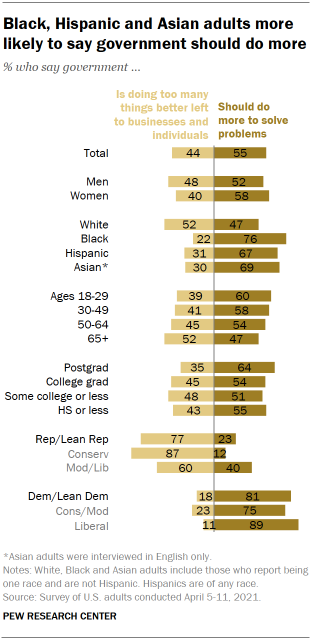
Women are slightly more likely than men to say that government should do more to solve problems (58% vs. 52%).
About three-quarters of Black adults (76%) and roughly seven-in-ten Hispanic (67%) and Asian adults (69%) say that government should do more to solve problems.
By comparison, White adults are about as likely to say that government should do more (47%) as they are to say government is doing too much better left to businesses and individuals (52%).
Younger adults are somewhat more likely than older adults to say that government should do more to solve problems. About six-in-ten adults under 50 (59%) say that government should do more; 54% of those ages 50 to 64 and 47% of those 65 and older say the same.
While about half or more of adults across all levels of education say the government should do more to solve problems, those with postgraduate experience are more likely to say this.
There are deep partisan divides on the role of government. About three-quarters of Republicans (77%) say that government is doing too many things that would be better left to individuals and businesses, while 81% of Democrats say government should do more.
There are also ideological differences within each party. An overwhelming 87% of conservative Republicans say the government does too many things, while a narrower majority (60%) of moderate and liberal Republicans say the same. Differences among Democrats are less pronounced. About nine-in-ten liberal Democrats (89%) say the government should do more, as do three-quarters of conservative and moderate Democrats (75%).
Democratic confidence in the future of the U.S. rises as GOP confidence drops
When it comes to their confidence in the future of the United States, about seven-in-ten Americans (69%) say they have either “quite a lot” or “some.” These overall views are little different than in August of 2020, when 66% said this. However, Democratic confidence is now considerably higher than it was last year, while GOP confidence is considerably lower.
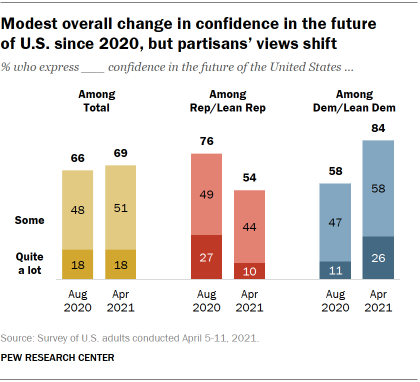
Today, 54% of Republicans say they have at least some confidence in the future of the country, with one-in-ten saying they have a lot of confidence. This is down significantly from last summer, when 76% expressed at least some confidence, including 27% who said they had quite a lot of confidence.
The pattern is reversed among Democrats. More than eight-in-ten Democrats (84%) now say they have at least some confidence in the future of the U.S.; in August 2020 a much narrower majority of Democrats (58%) said this.




